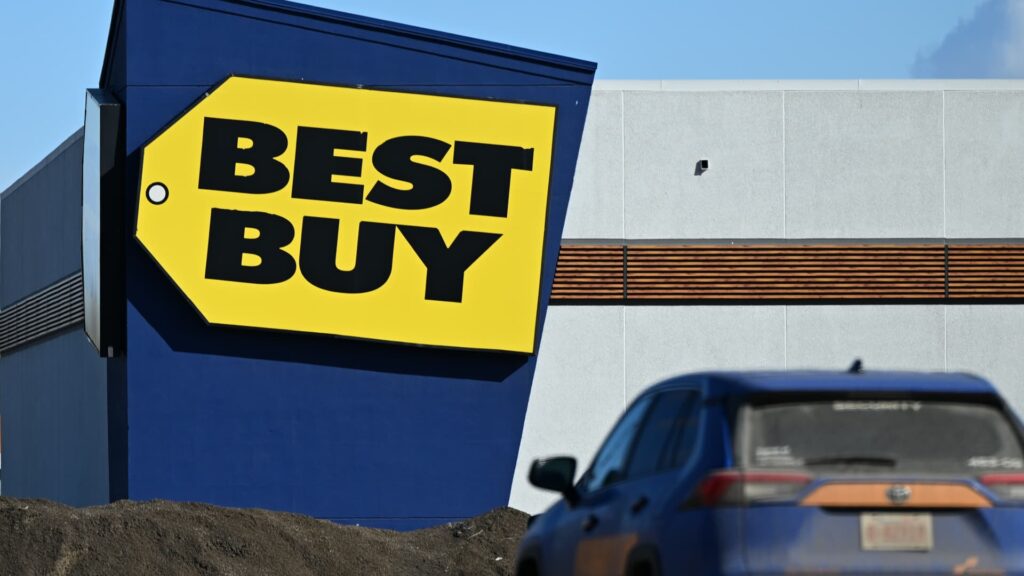Highlights;
- Best Buy beat Wall Street earnings and revenue expectations for Q2 2026 but maintained its full-year forecast due to tariff uncertainty.
- Revenue: $9.44B (vs. $9.24B expected), adjusted EPS: $1.28 (vs. $1.21 expected).
- Full-year guidance: $41.1B-$41.9B revenue, $6.15-$6.30 EPS.
- Q2 net income fell to $186M (vs. $291M YoY).
- Comparable sales rose 1.6%, the highest in three years, driven by gaming and computing.
- Shares closed down 3.7% to $72.66, down 15% YTD.
Best Buy Beats Wall Street Expectations but Maintains Conservative Full-Year Forecast
Best Buy surprised Wall Street by exceeding both revenue and earnings expectations in its latest quarter, though the company chose not to revise its full-year forecast, citing ongoing uncertainties related to tariffs. During the earnings call, CEO Corie Barry expressed growing confidence in the company’s plans for the second half of the year, noting that sales are trending toward the upper end of the projected range.
However, Barry emphasized that the potential impact of tariffs on both consumer behavior and the business itself has led Best Buy to maintain its annual guidance. The consumer electronics giant anticipates full-year revenue of $41.1 billion to $41.9 billion, with adjusted earnings per share (EPS) expected to fall between $6.15 and $6.30. This range reflects a slight adjustment from the previous fiscal year, when Best Buy reported $6.20 to $6.60 in EPS.
The midpoint of Best Buy’s revenue forecast is nearly flat compared to the previous year’s $41.53 billion. The company also expects comparable sales—a key metric that includes online sales and sales at stores open for at least 14 months—to range between a 1% decline and a 1% increase.
Chief Financial Officer Matt Bilunas noted that the full-year guidance accounts for potential slower sales in the third quarter, as consumers may delay purchases in anticipation of holiday deals in October.
Q2 Highlights
- Earnings Per Share (EPS): $1.28 (adjusted) vs. $1.21 expected
- Revenue: $9.44 billion vs. $9.24 billion expected
Best Buy’s net income for the quarter dropped to $186 million, or 87 cents per share, from $291 million, or $1.34 per share, in the same period last year. Adjusted EPS came in at $1.28, and revenue increased slightly from $9.29 billion in the year-ago quarter.
Strategies for Growth
Best Buy is navigating a challenging environment where higher interest rates and tariff uncertainties have led consumers to delay purchases of big-ticket items like kitchen appliances and electronics. To address these challenges, the company has implemented several strategies:
-
Third-Party Marketplace: Best Buy recently launched a third-party marketplace to expand its product offerings, allowing external sellers to list their items on the company’s website and app.
-
Price Adjustments: To combat higher costs due to tariffs, Best Buy has increased prices on select items, though Barry described this as a “last resort.”
-
Back-to-School Season Strength: The company reported strong customer response to its sales events during the back-to-school season, a crucial period for laptop, tablet, and other tech sales.
-
Focus on Innovation: Barry highlighted the importance of innovation, noting that Best Buy’s business model performs well when new technologies are introduced. For example, the computing category saw its sixth consecutive quarter of sales growth, and the company reported its highest number of second-quarter laptop unit sales in 15 years.
-
Gaming Success: Gaming was a standout category, with stronger-than-expected sales driven by the release of the Nintendo Switch 2. Best Buy capitalized on the console’s launch by offering pre-orders and opening stores at midnight.
Shopping Patterns and Consumer Behavior
Barry observed that shopping patterns at Best Buy remain consistent with previous quarters, with customers being “resilient but deal-focused.” The company’s comparable sales rose 1.6% in the fiscal second quarter, marking the highest growth in three years. However, this growth was partially offset by weaker sales in categories such as appliances, home theaters, and tablets.
In the U.S., comparable sales increased 1.1%, driven by strong performance in mobile phones, gaming equipment, and computing products. Investors are closely watching for signs of a rebound in the replacement cycle for items like laptops and kitchen appliances, which consumers stocked up on during the Covid-19 pandemic.
Initiatives for the Back Half of the Year
To boost sales in slower categories like appliances and home theaters, Best Buy plans to sharpen price points, adjust merchandise offerings, and expand staffing. The company has increasingly relied on vendor partners to staff stores, with employees from brands like Apple and Samsung supporting sales in specific areas. Barry expects these contributions to increase in the back half of the year.
Additionally, Best Buy is experimenting with new in-store experiences, including mini-showrooms in partnership with Ikea featuring kitchen and laundry room appliances. The company is also collaborating with brands like Breville and SharkNinja to showcase trendy products and has created areas where customers can try out Ray-Ban and Oakley sunglasses using Meta’s AI technology.
E-Commerce Performance
Best Buy’s U.S. online sales grew 5.1% year over year, accounting for about a third of the company’s total U.S. revenue in the quarter.
Investor Response
Shares of Best Buy closed at $72.66 on Thursday, down 3.7% for the day. Year-to-date, the stock has declined about 15%.
For now, Best Buy is taking a cautious approach, balancing optimism about its second-half plans with prudence in the face of economic and tariff-related uncertainties.
Source: https://www.cnbc.com/2025/08/28/best-buy-bby-earnings-q2-2026.html


